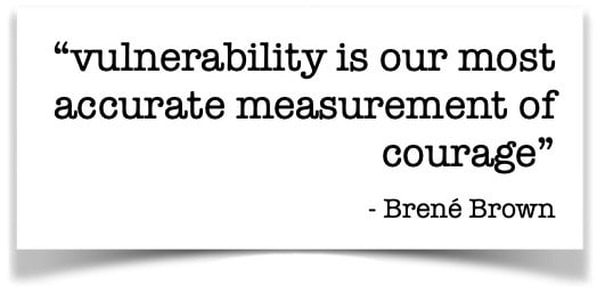 Oscar Zoroaster... how many of you know who that is? I would guess the majority of people would say they have no clue. How about the Wizard of Oz? Yep - one and the same. He’s the flustered man behind the curtain who is afraid to be revealed for who he is. I’m sure everyone has felt like they have spent some time hiding behind the curtain. Let’s talk about what can happen after we step out and allow ourselves to be seen. Putting a piece of yourself out there without a safety net can be excruciatingly difficult. Allowing scrutiny and judgment in any form can be terrifying but it is the origin of freedom, authenticity, creation, and meaningful connection. Vulnerability hangover. Brené Brown coined the phrase that today has over 360,000 search results on Google. “vulnerability is our most accurate measurement of courage — to be vulnerable, to let ourselves be seen”* We all know the feeling even if we are unfamiliar with the phrase. Vulnerability is stepping out of our comfort zone to share an authentic part of ourselves with no assurance of acceptance. The hangover is the horrible feeling of regret, fear, or uncertainty that follows our disclosure. It’s also very normal. The word I think best describes what a vulnerability hangover feels like: OVEREXPOSED. We may as well be standing in public naked for the feelings that can come rushing forward when we let our true colors be seen. No matter how much I tell myself that it is brave to risk and be vulnerable, I still catch myself thinking “What the what… why on earth did I say that?!”. I wish I could suck the words back in, fold inside myself and disappear depending on the level of vulnerability. There are no set rules about to how we experience it. What seems risky to one may appear safe to another. We might feel it immediately as the last syllable hits the air or it can be delayed and sneak up on us down the road. A consideration or two about how we step into bravery. The level of risk we take should be in proportion to the trust we have with the person we are sharing with. I wouldn’t advise sharing your most embarrassing moment with the person who always has the latest dirt to dish, but a trusted friend may be a good place to practice if they have proven that they can catch you with empathy and not judgment. We also have to feel ready. Ready is not the same as perfect. If we wait for all the stars to align, we will never move. We do however have to feel as if we are authoring our own story. Never, ever let anyone push you into self disclosure or moving forward in any area of risk, otherwise we feel resentful or even victimized - and we are aiming for authenticity and freedom. How much of a hangover we feel will depend on the content of the disclosure. Was it a thought that someone might judge as strange, or did I just jump into the deep end of the pool and reveal something that I thought I’d take to the grave? The level of exposure and risk will dictate the intensity of the hangover. Part of the privilege of being a therapist is that I get to witness bravery in action every day. It stirs up strong feelings whenever I see a client reveal a part of themselves that they have worked tirelessly to contain. It is humbling, inspiring, and beautiful to witness someone invest in themselves enough to risk being seen. It is transformative. It is also contagious. I find that I am often inspired and take a cue from my clients who show the courage to create something different for themselves by stepping out of the shadows into the light. So what’s the cure to a vulnerability hangover? In my experience - time and compassion. It's critical to allow ourselves time to sit with the understanding of the courage it takes to lower the mask long enough to be seen. It also takes a bucket-load of compassion. It’s easy to judge ourselves harshly or critically, but holding ourselves in compassion is where we will find freedom and release. By the way - I have found that the people who judge you the most critically are the ones who don’t understand the integrity of vulnerability, opting to criticize others who demonstrate the courage they lack. My people are the messy and frazzled ones who would rather be real than perfectly polished. So let’s not confuse being strong with being an impenetrable force. The man behind the curtain went to exhausting lengths to maintain the great and powerful persona that was ultimately exposed as smoke and mirrors. Oscar Zoroaster found his own path to freedom by connecting with other lost souls on their own journey of self discovery. Be brave! *TED. (2012, March 16). Brené Brown: Listening to shame [Video]. YouTube. http://www.youtube.com/watch?v=psN1DORYYV0
1 Comment
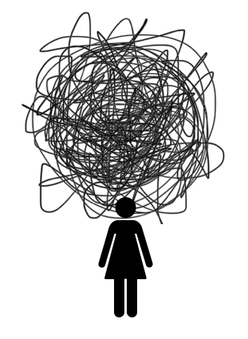 This is what I’ve been feeling like. 746 tangents, incomplete thoughts, worries, to-do’s, “shoulds” all spinning around my head. The chaos is winning today. What are we supposed to do on those days when we feel like the tangled scribble is getting the best of us? I often find myself feeding the tangle just to see just how big it can get, and honestly I’m not a masochist. Trying to get myself on track; whether the track of productivity, awareness, connection, creativity, self compassion, I often feel like I can’t approach any of that until I untangle the entire ball of confusion surrounding me. Untangling is hard. Thoughts seemingly enjoy snowballing and taking us for a ride that is anything but fun. It makes me think of those godawful playground roundabouts. You know, those round spinning platforms of nausea? Under the guise of “fun”, I was first introduced to that sadistic device of torture at an early age. I remember seeing all the kids laughing and spinning, and I wanted to partake. As soon as I got on I was met with that familiar feeling of not fitting in. I knew it was supposed to elicit something other than an immediate raging headache, quickly followed by vomit, but then I never felt like other kids. That deceptive shame-brain in action that tells us what we should experience somehow never seems to match what we actually experience. In my patterned reasoning, the tangle has a simplistic narrative attached. It says; here are all the thoughts, feelings, and situations that you need to sift and sort through. Just prioritize, organize, and start working through one by one, and the knots will slip away. Reality unfolds like the the roundabout. This is what you tell yourself it should be like, and here comes your wacko reality. Everyone else can untangle and spin with glee, you get confused and throw up. Why is it that we make ourselves feel like the anomaly? We convince ourselves that we are that weird outlier. The one who lives with a snarl of buzzing confusion, always mocking our ability and strength because we see our differences as flaws. Our reality isn’t wacko, it is our individuality at its best and most challenging. We see the tangle as the source of our suffering, but actually the story we tell ourselves about the tangle is what directs the outcome. Do we tell a story that paints us as an oddball outcast, a villain, a victim, a hero? The tangle is everything that life presents to us. Problems to solve, challenges to meet, experiences to process, relationships to navigate. So we can approach it like it’s a monster under the bed waiting to pull us under or we can start looking for the end of the thread to begin unwinding. Or we can throw up.  When anyone asks me how I am these days, my most honest response is “I’m doing the best that I can”. It seems to cover the breadth of my rapidly changing moods and feelings that sweep in and out. Until recently, the story I’d been telling myself was that everyone is worn down by 2020 so writing about it won’t do much to turn the tide. Well, then I thought, what tide am I trying to turn? As a therapist, I challenge clients regularly to examine their behaviors to understand motivation. Am I writing for external approval or am I writing because of what it offers me? Waiting for grand gestures of impact and change will have us spend our time simply watching the world go by. I talk to people all day long about how clarity of intentions is critical to mindful self awareness. I am a writer, which compels me to employ that outlet to process thoughts, work through feelings, share, connect, explore, and foster hopefulness. It is a conduit to knowing myself and yet for longer than I care to admit I expended considerable energy avoiding writing instead of giving myself permission to engage. In a sense, I’ve been hiding; mostly from myself. Since I became a therapist I have always clearly and intentionally held the line that limits self disclosure so as not to muddy the waters of my work in my practice. When clients know too much about their therapist, the relationship boundaries can be blurred, and the objectivity and intentions can come into question. It isn’t that clients know nothing about me, they do. I share things when and if I feel it may be relevant to their growth and healing. My responsibility privileges client care no matter how much something might touch me, trigger me, or speak to me personally. I don’t share things with clients for my benefit; I have my own therapist for that. The reality is that my life is not limited to that one role, so finding comfort in using my voice publicly can be challenging. 2020 has heightened my awareness that we are all walking a shared path in places. Regardless of how many details of our lives are unique to us, so many similarities exist. As someone who sits with a wide cross section of people every day, I see the disservice in perpetuating unattainable expectations. There isn’t a “right” way to navigate a time like this. Regardless of outward appearance, no one is immune to the uncertainty that this year has presented to us. We are bombarded by daily messaging of “us” and “them”, but it is most certainly a time of “we”. The focus of our nation today is top-heavy in the places of division. Politically, socially, spiritually; so much energy is expended around who and what is “right”. There will never be a neon sign directing us to one true path, it is ours to pave and it should be founded in our values. The sticky part will always be in how we handle places of difference. We are weary, and that’s to be expected. I am actually grateful that many people are finding it harder and harder to maintain the Facebook facade of what our lives “should” look like. 2020 can offer us a platform to highlight the freedom and empowerment found in our own uncertainty. When we acknowledge our places of suffering, challenge, and doubt we give ourselves and others consent to experience the entirety of our lives instead of hiding and shaming ourselves for our own humanity. Authenticity has us examine the difference between control and influence. I can’t control ugly politics, social unrest, or ending a global pandemic. I do have influence, even if it begins by exploring my own judgments and beliefs. I hold the belief that courage can be contagious. Risking in any capacity is vulnerable. Allowing ourselves to be seen (safely) is the only way we can truly thrive and experience genuine connection. It isn’t a show of strength to hide the messy parts. Courage can’t exist without fear; courage is born in the face of fear! We all have influence and we all have a voice. Yes, I can vote, I can peacefully protest, I can wear a mask to protect the vulnerable, I can offer kindness, I can write, I can advocate for those without my privilege. I can also advocate for myself. I can struggle, be confused, get sad and mad, screw up, and make mistakes. Authenticity rarely appears in an impeccable outfit and perfect hair, it usually stumbles in as I run into people at Target after not showering, wearing a baseball hat and some remnant of food on my shirt. I rarely cross paths with anyone when I’m put together. To me, being real means that I accept that my life can sometimes look like a sh#t-show, comedy of errors. I believe the occasional, or continued, chaos isn’t the measure of my worth and value. Reinforcing that belief requires regular attention because it isn’t always easy to embrace, but it allows me to find connection with others who are equally messy. That feels a lot better than trying to force feed the story of who we should be, but aren’t. I don’t care who you are or what you do, we are all facing difficult decisions without clear cut answers. Do I send my child to school or do I keep them home? How is that an easy decision? We are meant to wrestle with hard things because these things matter. We are all experiencing places of confusion instead of confidence. It doesn’t mean we are doing it wrong or that someone else is doing it better. Let’s find the blessing in the disarray, because the scary uncertainty of a global pandemic can be the catalyst to let go of the illusion of control that so many of us chase. These are trying times that will test all of us in ways we couldn’t have predicted. Don’t hide that. Don’t perpetuate the myth that perfection is attainable. Our strength is not defined by the absence of fear, and confidence isn’t about certainty. Share your struggle, let people see the cracks - it’s where we find our most profound connection in knowing we aren’t alone. Adjust our aim away from how we think we should be doing to more accurately reflect how we are. I think we’re doing pretty well when we believe and strive to continue to simply do the best that we can.  Therapy Costs Too Much! What’s the ROI? Therapy IS expensive. Period. How would our perspective shift if we were to consider it through the filter of a return on investment (ROI)? What kind of return do we expect for an investment in mental health care? There can be both short and long term gain through personal growth, and yes, that's difficult to measure objectively. It truly is an investment in our future. What type of return do we expect on other investments, and how do we measure results? Lots of questions to ask. What we privilege reveals what we value To lend perspective, let’s do some comparative analysis. We can set aside money for vacations, home improvements, or college funds, but we tend to be much more reluctant to spend money for our emotional well being and relationship development. Think of the costs for a new outfit, hair cut, dinner out, concert or sporting event; it can quickly add up. The return on our investment may be short lived, and there's nothing wrong with that as long as we give equal consideration to where all of our money goes. It is interesting that therapy can land in the column of an unnecessary overpriced luxury, but we may consider cable and internet essential expenses. When we ask where emotional care falls on our list of priorities, we will quickly learn what we privilege and value. While most current research on divorce cost statistics are estimated and somewhat subjective, there is a widespread general consensus that the cost of a divorce in the US continues to rise. “Divorce is a big business in the United States. It is in fact a $28 billion-a-year industry with an average cost of about $20,000.” * Now consider the comparative investment in therapy. No, there is no guarantee, but if engaging in therapy is an action oriented step towards personal growth, authenticity, and better relationships, doesn’t that make it worth serious consideration? *http://www.divorcestatistics.info/how-much-does-divorce-cost-in-the-usa.html 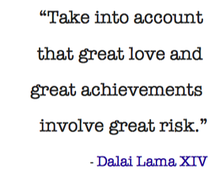 It might not work. This may be true, but of course it is never that simple! Many people never engage in therapy because it feels too intangible; there are no guaranteed results, so it’s important to consider expectations. If any licensed mental health provider promises results, beware! There are many factors impacting therapeutic outcomes, and I encourage up front discussion of expectations with any potential therapist. To fully engage in life means that we develop courage by stepping into the unknown. This doesn’t mean we do so blindly, we need to be deliberate and do our homework to make sure we are making informed decisions. Informed does not equate to guaranteed. Life doesn't come with a warranty. Assessing the potential risk As we explore and confront places of pain, things may get worse before they get better; we are intentionally facing problems rather than avoiding them. The notion of exploring the challenges in our life becomes less daunting when we can step in with someone who is capable, compassionate, and objective. Assessing the potential benefit Yes, it is important to recognize the risk of any activity we choose to engage in, but the potential payoff is what fuels our motivation and should be considered equally. If we are open and willing to employ new strategies with someone trained in this work, the results can be life changing. 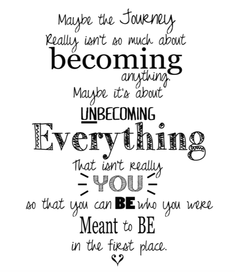 I can’t change who I am. A good mental health clinician doesn’t want to change who you are either! In fact, much of the process value lies in creating a deeper understanding of who we really are, not just who we think we are. It’s about developing a greater acceptance and compassion for our own unique personality; exploring growth opportunities from a more empowered position. Doing vs. Being The therapeutic approach is ultimately designed to highlight the difference between identity and behavior. Too often we tie our sense of self to outward action, and there is a huge difference between who we are what we do. Some of our less than helpful behaviors mute our personality and take us further away from our true self. Successfully engaging in therapy means that we explore and challenge the thoughts, feelings, and behaviors that get in the way of being the person we were created to be. The path to living a life of authenticity and freedom isn’t easy, but it is worth it. It requires honest observation and a desire to understand and work on what can be changed, and create a healing space for what cannot. 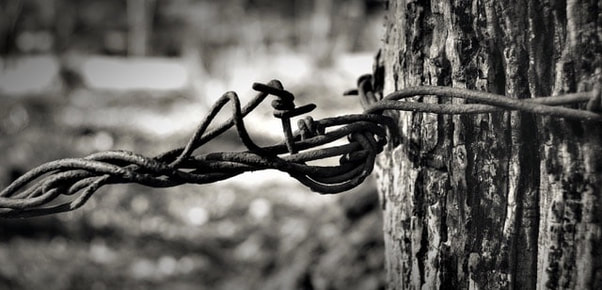 Therapy is for people who… The second reason we don't go to therapy, no one want's to be described as the person who needs therapy. Let’s explore how some people might finish the sentence "Therapy is for people who..." Which of the following descriptions do you relate to? The Antagonist "Therapy is for people who can’t hack it on their own." They use words like; weak or crazy and then they may or may not claim to be kidding. First to make fun of therapy either overtly or covertly. Feeds the fears and builds the negative perception with jokes and criticism. The Quiet Bystander "Therapy is for people who need some kind of help?" Their comments feel more like questions because emotional care is mysterious and maybe scary. Constitutes those in the crowd who feel uncomfortable with the topic; they avoid discussions around mental health. They allow uncertainty to quell their voice, so they say very little for or against. Content remaining uninformed and without a solid opinion. The Inconsistent Supporter "Therapy is for everyone, except me." Full on supporter for the people who really need “that kind of help”. Describes the type of person who engages in therapy with adjectives that exclude themselves. Outwardly supportive, but inwardly carries unspoken judgement or misinformation that makes it fine for others, but it isn’t for them. The Hesitant Participant "Therapy is for people who need some outside perspective and help, but no one better find out that I go to a therapist!" Bravely engages outside help, may or may not work hard in therapy, but they do not want others to know they go to therapy.* (see important note below) The Advocate "Therapy is for people who recognize that life is full of ups and downs and it's ok to engage outside support." The person who positively encourages and defends mental health care. They are willing to talk about emotional health, and they prioritize it for themselves. We need advocates, so how do we recruit and create more of them? I will be a broken record throughout this blog series… Start a conversation. Talk to other advocates and be curious. How do we change any kind of preconceived impression about therapy and mental health care? Inform and equip yourself. Feeding the larger story is easy, but confronting ignorance takes courage. So who are the real people who engage in therapy? If I were to describe the people I have worked with in therapy, they don’t fit any stereotypical characterization; there is no "type". Of course I work with people who are skeptical, some choose not to engage, and some people just are not ready to put forth the effort. The majority of my clients are willing to work hard despite the apprehension of stepping into unknown or uncharted territory. They are courageous and willing to be introspective. I have the privilege of sitting with clients who boldly face some incredibly painful circumstances and show remarkable resilience. I have nothing but the most profound respect for anyone who is willing to confront a challenge and create something different for themselves and their relationships. Therapy is for people who want to grow and learn and break patterns of unhelpful behaviors, and they are willing to do the work to make it happen. *When it comes to participation in therapy, confidentiality in the process is a critical component. As a therapist I am bound by strict regulations to preserve client’s privacy and confidentiality. There are MANY factors to consider about confidentiality outside the scope of this article, so this is NOT to advocate any disclosure about participation in personal therapy. We can be full advocates of mental health care without sharing anything about our personal experience in therapy if we so choose. Examination of the rationale behind whatever choice we make is something that each individual must clarify for themselves, responsibly, and safely.
 Intellectually we understand mental health care is important and most people profess a desire to lessen the stigma. I have to believe a time will come when our emotional health is viewed in the same light as physical health. Most of us are able to recognize the benefits of preventive health care check-ups, exercise and good nutrition. We might agree in theory that mental health care is important, yet it seems as though it only gets widespread attention when we find ourselves scrambling in response to a loss or tragic event. The spotlight shines brightly on on mental health awareness when we use hindsight to second guess and pass judgement on missed opportunities, and signs we failed to see and act on. Confronting Stereotypes Serious mental illness is not the focus of this piece. However we cannot respond effectively to the larger issue of mental illness if we do not step back and first consider preventive mental health care. Proactively addressing an issue will typically result in greater success than a reactive reply to a crisis. We have to start by confronting the stereotypes attached to therapy and people who go to therapy. Those who have not done focused self work with a therapist cannot be expected to fully understand what it offers. In my experience, those who initiate therapy do so to take responsibility and control of their own well being in a way that many do not. Change the Mindset We must stop casting aspersions on therapy. Are you an advocate or an antagonist? Stand up and start the conversation. Today. Now. If we want to normalize and endorse the importance of emotional health we must take responsibility for our role in changing the mindset. We must equip ourselves with information and understanding. We need to bravely step into dialogue, demystify the process, and dispel the misconceptions about mental health care and therapy. If we want to change the perception, we can’t be afraid to talk about it. Start a Conversation In the coming weeks, my hope is to use this blog to initiate conversation about why we don’t go to therapy. Please feel free to share your comments and start talking with friends and family members. We can’t make a difference if we perpetuate the silence. I'll kick things off with a very common concern I hear about therapy, the stigma itself. What will people think if they know I’m in therapy? On that same note, I also hear, "people will think I’m weak if I can’t fix my problems on my own". It was Albert Einstein who said “We can’t solve problems using the same kind of thinking we used when we created them”. It's amazing how we can make universal logic situational! How many areas of our life are we considered weak if we seek to expand our understanding and knowledge base? How about if we need expertise? Are we ashamed to admit we hire accountants to help us with our taxes, personal trainers for fitness, doctors, lawyers, hair stylists, tutors, mechanics, computer techs? We can justify contracting virtually any other service provider without shame. For some reason, personal issues fall into a unique category of exception, as if we shouldn’t need to engage someone to help us with emotional challenges. How do we overtly or covertly feed into this way of thinking? If we are stuck and not getting much traction in dealing with an emotional or relational problem, it should show strength of character to seek the support of someone trained in that area to help us. It should not induce shame or secrecy. We encourage others to ask for help, but do we take our own advice? Are you an advocate or a silent participant? If you want to be part of the solution but don't know what you can do, just start a conversation, you never know who you may be helping! Check back in the days to follow for additional discussion points about why we don’t engage; along with some suggestions and alternate perspectives to consider. Please forward to friends, family, and co-workers to continue the conversation. We CAN make a difference together.
 Anxiety shows up in some form or another for all of us. Anxiety is not the same as an anxiety disorder. As with any upward trending mental health condition, it can become whitewashed and we can confuse day to day stress with an actual anxiety disorder. Anxiety is an innate survival instinct connected to the threat detection system in our brain. It serves an important function as it alerts us to potential dangers in our environment and keeps us safe. It is only classified as a disorder when anxiety kicks into overdrive and it becomes unhelpful and interferes with our ability to function normally. Defining the optimal level of anxiety is the challenge. We all have a unique response to differing levels of anxiety and to different stressors. Begin by asking yourself if your anxiety get’s in the way of everyday activities? Does it keep you from doing things you should do or want to do? Do you find yourself doing things targeted specifically on reducing your anxiety? Sometimes it drives us to plan and manage and control our world so we can feel prepared for whatever comes our way. Invariably, the result is not what we hope for. We may avoid situations, people, or events. We may disconnect and shut out anything we deem as a potential threat and live in a hyper-vigilant state that leaves us unsatisfied, isolated, and frustrated. It is exhausting to live in fearful anticipation; waiting for the next worst thing to happen. The question we need to ask ourselves is how much time do we spend feeling anxious or responding to our worry? How much of our time and peace of mind do we hand over to our fears leaving us feeling helpless and stuck? We privilege discomfort and pain over more tolerable emotions, so we are more sensitive to the feelings connected to anxiety. As a result, we tend to label anxiety as “bad”. The anxiety is not the bad guy in our story, it is our response to anxiety that causes suffering. Symptoms can look like excessive worry and an inability to control worry, avoidance behaviors, and intrusive thoughts. There are also physical manifestations* that include feeling restlessness or feeling keyed up or on edge, being easily fatigued, difficulty concentrating or mind going blank, irritability, muscle tension, sleep disturbance (difficulty falling or staying asleep, or restless, unsatisfying sleep) (Source: DSM-5). If any of those things get in the way of your day-to-day life, you may be struggling with anxiety or an associated disorder. Anxiety disorders are the most common mental illness in the U.S. today, affecting 40 million adults in the United States age 18 and older, or 18% of the population. (Source: National Institute of Mental Health) Because the prevalence is so high, you will find endless sources of self help, “fixes”, self proclaimed “experts” and “professionals” who prey on those who are suffering and looking for help. Beware of anyone or anything that claims guaranteed results. We cannot remove anxiety from our lives or seek a "cure", but with hard work we can learn to manage the symptoms of the disorder. Dealing with excessive anxiety can feel like a life sentence. People can label themselves and say, "I'm just a worrier", believing it is a personality trait they are destined to carry, but it doesn't have to be your defining story! If you decide to seek help, look for credentials. Check for academic degrees, professional and/or state licenses, association affiliations, and any evidence of experience and expertise. In addition to the level of qualification, your comfort level with your therapist is always a key factor in your ability to fully engage and see positive results in the process. Choose carefully to find a good fit, you will be glad you did! *To address any potential underlying health condition(s), always be sure to consult your primary care physician to discuss any physical symptoms you may be experiencing. Helpful Anxiety Resource Links:  “It isn’t what happens to us that causes us to suffer; it’s what we say to ourselves about what happens.” ~Pema Chodron This is the second part of a two part blog post on relational endings and working through How frustrating is it to hear that to heal from pain, we have to sit in it? If you’re anything like most people, the prospect of “working through” feels as comforting as chewing on aluminum foil. Who wants to knowingly call up all of the emotions that have been shoved into a deep compartment labeled “do not enter under penalty of emotional meltdown”? Perhaps you are the type who never put the emotion aside and you are riding an endless wave of feeling overload that you call grief. Or maybe you find the one emotion you are most comfortable with and you filter your entire grieving process through that one feeling and call it good. Some of us want to treat grief like ordering a meal at a restaurant “OK, I’ll start with a small plate of denial, I’ll take my anger rare, with a side of bargaining, and I’m too full for depression so I’ll finish up with a cup of acceptance.” Check please! Done and done! These may be tongue in cheek analogies, and the truth of the matter is that most of us don’t even understand what it means to work through complex emotion or grief. This is where we can get stuck. We may fail to validate the depth of our pain or we may get swallowed by it. We may fixate on our role or refuse to take any ownership at all. We can’t dismiss the importance of working through the pain before we can get past it. Dismissing the process discounts our experience leaving little room for accountability and self compassion. There is no one recipe for relief, and every path is different. To find the road that’s best for you it is often helpful to get curious. Spend some time journaling and reflecting. If you are thinking about the relationship specifically, what did it offer you? What did you learn? What was challenging? How did it make you feel? When was it good and when did you struggle? What did YOU bring to the table? Every relationship provides us with an opportunity to reflect on the gifts we offer to those we are in connection with as well as revealing our opportunities for growth and change. No experience is wasted if we are able to stop and reflect, honestly. Consider using mindfulness and self compassion as you contemplate what it means to work through. Mindfulness is when we purposefully pay attention, in the present moment, without judgement. Why mindfulness works hand in hand with self compassion is that we often struggle with that last piece… "without judgement". Self compassion requires that we recognize our own suffering. Often times we opt for self judgement over compassion because we feel internal and external pressure to be strong, move past, and tough it out! In the process we shame ourselves for feeling the pain instead of acknowledging our suffering as real. When we can mindfully explore our relationships, our experiences, and our suffering, we can learn a great deal from our reflections. If we don’t assess what’s going on inside of us, we can repress or project our suffering instead of owning it. We may find ourselves back on the same hamster wheel recreating the same pattern in the next relationship. Beyond reflection, we need to consider what it means to let something go. While an overused and often misunderstood concept, when it comes to emotional health, letting go is critical to our ability to work through and move forward. It isn’t about denying the situation or the impact, but radical acceptance of the experience in its entirety; pain and all. Jon Kabat-Zinn, the author of Wherever you go, there you are: Mindfulness meditation in everyday life describes it this way “To let go means to give up coercing, resisting, or struggling, in exchange for something more powerful and wholesome which comes out of allowing things to be as they are without getting caught up in your attraction to or rejection of them. We hold on with our minds. We catch ourselves, get stuck ourselves, by holding, often desperately, to narrow views, to self serving hopes and wishes.” Pema Chodron, an American Buddhist nun talks about letting go of our suffering with a simple analogy of being knocked down by a wave. We can lie there, not get up, and eventually drown, or we can get up and keep moving forward. We fail better. We will get knocked down again, but the more we get up, the smaller the waves become if we keep moving forward. Chodron says “We think that the point is to pass the test or overcome the problem, but the truth is that things don't really get solved. They come together and they fall apart. Then they come together again and fall apart again. It's just like that. The healing comes from letting there be room for all of this to happen: room for grief, for relief, for misery, for joy.” The confusion about what it means to work through our emotional experience has shrouded the concept in mystery. It’s as if there is a code to decipher and a secret set of instructions we didn’t get. When we are able to work through, it isn’t a realm of enlightenment where we no longer encounter adversity, we simply begin to understand that when we do suffer, the pain creates fertile soil to grow instead of stagnate. If you find yourself journeying through a breakup and it feels like trudging through quicksand, know that you aren’t alone! We all walk through places of pain and loss that leave us confused, hurting, and lonely. Our tendency may be to isolate in an attempt to prevent this kind of hurt from happening again, but this is the place we need to recognize the commonness of our connection. The literal meaning of compassion is “to suffer WITH” (Neff, 2011). The “with” guides us to understanding that these are the experiences that most connect us to other people because of the commonality of suffering. Instead of focusing on feeling isolated, alone, and inadequate, know that we all suffer, we all experience pain. Be courageous, compassionate, and boldly break the cycle to create something different! If you need a kick start or feel as if you can’t get “un-stuck” on your own, it may be helpful to speak with a professional, someone who is trained in emotion and relationships to walk with you through this process. Gina Waltmire, LMFT Gina is a licensed marriage and family therapist practicing in Overland Park, KS References: Chödrön, P. (2000). When things fall apart: Heart advice for difficult times. Boston: Shambhala. Kabat-Zinn, J. (1994). Wherever you go, there you are: Mindfulness meditation in everyday life. New York: Hyperion. Neff, K. (2011). Self -Compassion: The proven power of being kind to yourself. New York: HarperCollins. Other helpful resources and links: http://www.huffingtonpost.com/kristin-neff/self-compassion_b_1889880.html https://www.lionsroar.com/how-to-move-forward-once-youve-hit-bottom/ |
Stay ConnectedCheck the RSS Feed link below to receive the latest resources, articles, and blog posts that may be of interest to you. Archives
March 2021
Categories |
Gina Waltmire Therapy, LLC
Gina Waltmire, MS, LCMFT
ADDRESS6701 W. 121st St., Suite 302, Overland Park, KS 66209
|
Telephone913-735-0033
|
|
 RSS Feed
RSS Feed